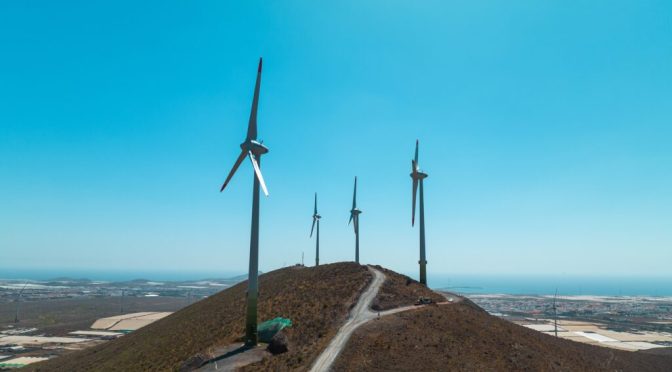Agüimes and Camino de la Madera will produce wind energy equivalent to the annual consumption of more than 17,000 homes, and will contribute to reducing annual CO2 emissions equivalent to removing nearly 14,200 vehicles from circulation. The Agüimes wind farm makes this municipality in the Canary Islands one of those with the largest number of Naturgy renewable projects in the archipelago.
Naturgy has started the operation of two new wind farms in the Canary Islands, with which there are already a dozen that the energy multinational manages in the Canary Islands, with a total installed capacity of 94.8 MW. The two new parks are Agüimes (10.75 MW), located in the municipality of the same name, and Camino de la Madera (9.2 MW), in Santa Lucía de Tirajana, both on the island of Gran Canaria.
The construction of the two parks has represented an investment of 20.5 million euros and has generated nearly 150 jobs, both direct and indirect, with the collaboration of 16 companies on the island.
The Agüimes and Camino de la Madera parks will produce energy equivalent to the annual consumption of more than 17,000 homes, and will contribute to reducing annual CO2 emissions by 35,500 tons, which is equivalent to removing nearly 14,200 vehicles from circulation each year.
Agüimes, a reference municipality for Naturgy
The Agüimes wind farm is the third that will contribute the most Naturgy production in the archipelago, after Puerto del Rosario and Piletas I. With 32 GWh/year of energy, its production will be equivalent to the annual consumption of more than 9,300 homes, and will avoid the emission of more than 21,800 tons of CO2.
Equipped with three wind turbines, the Agüimes park has required an investment of 10.6 million euros. This municipality is thus consolidated as one of those with the largest number of Naturgy renewable facilities in the archipelago. Along with the new park, the company also manages Piletas I, which, with 12.8 MW of power, is one of those that provides the highest production of all the company’s wind farms in the Canary Islands. With about 45 GWh/year, the energy produced by this park represents the annual consumption of about 12,900 homes, equivalent to that of the entire municipality of Agüimes. This facility prevents the emission of more than 25,000 tons per year of polluting and greenhouse gases.
During 2023, Naturgy’s renewable capacity in this municipality will grow with the new scheduled solar generation capacity. When this year ends, Agüimes will have five photovoltaic plants promoted by Naturgy: Gran Canaria I, Gran Canaria II, Telde I, Telde IV and Telde V. The first two will have a similar total installed power, 6 MW each, and will produce in a total of 24 GWh/year of energy annually, which is equivalent to the electricity consumption of 6,700 homes per year. Telde I will have a total installed power of 3.6 MW and an annual production of 7 GWh of energy, equivalent to the annual electricity consumption of 2,000 homes. Finally, Telde IV, with 2 MW of power and an annual production of 4 GWh, and Telde V, with 1.8 MW and 3.5 GWh/year, will represent the annual consumption of more than 1,150 and 1,100 homes, respectively. The five projects represent a global investment by Naturgy of 20 million euros.
For its part, the Camino de la Madera wind farm, in Santa Lucía de Tirajana, is equipped with four wind turbines, and the investment made has amounted to nearly 10 million euros.
Camino de la Madera will produce 27.5 GWh of energy per year, which is equivalent to the annual electricity consumption of 7,800 homes. This new infrastructure will make it possible to displace the use of other sources of conventional electricity generation and will contribute to reducing annual CO2 emissions by more than 13,700 tons, in addition to other polluting emissions.
In 2022, the ten wind farms that Naturgy had assets at the time produced more than 211 GWh of energy, which represented an increase of 6.5% compared to 2021, equivalent to the annual electricity consumption of nearly 122,000 homes. Thanks to the energy produced by these wind farms, during the past year it was possible to displace the use of other sources of conventional electricity generation, contributing to a reduction of around 275,000 tons of polluting and greenhouse gas emissions.
Presence in the Canary Islands
In addition to the twelve wind farms that the company has in the Autonomous Community, the energy multinational was the highest bidder in the auction of the first bidding process for photovoltaic capacity endowed with Feder funds (SolCan), with 44 MW of power, and the second largest bidder for the power auctioned in the Canary Islands in the second bidding process for wind capacity endowed with Feder funds (EolCan2), with 20 MW of power. Looking ahead to 2023, the energy company plans to complete eleven new photovoltaic projects, which will mean a total of 50 MW of power.
Thanks to these thirteen new photovoltaic and wind projects, which represent a total of 70 MW and a global investment of 80 million euros, 156 GWh/year of electricity will be generated.
In addition, the company is working on the development of other photovoltaic and wind projects, as a sign of its commitment to the energy transition on the islands.


